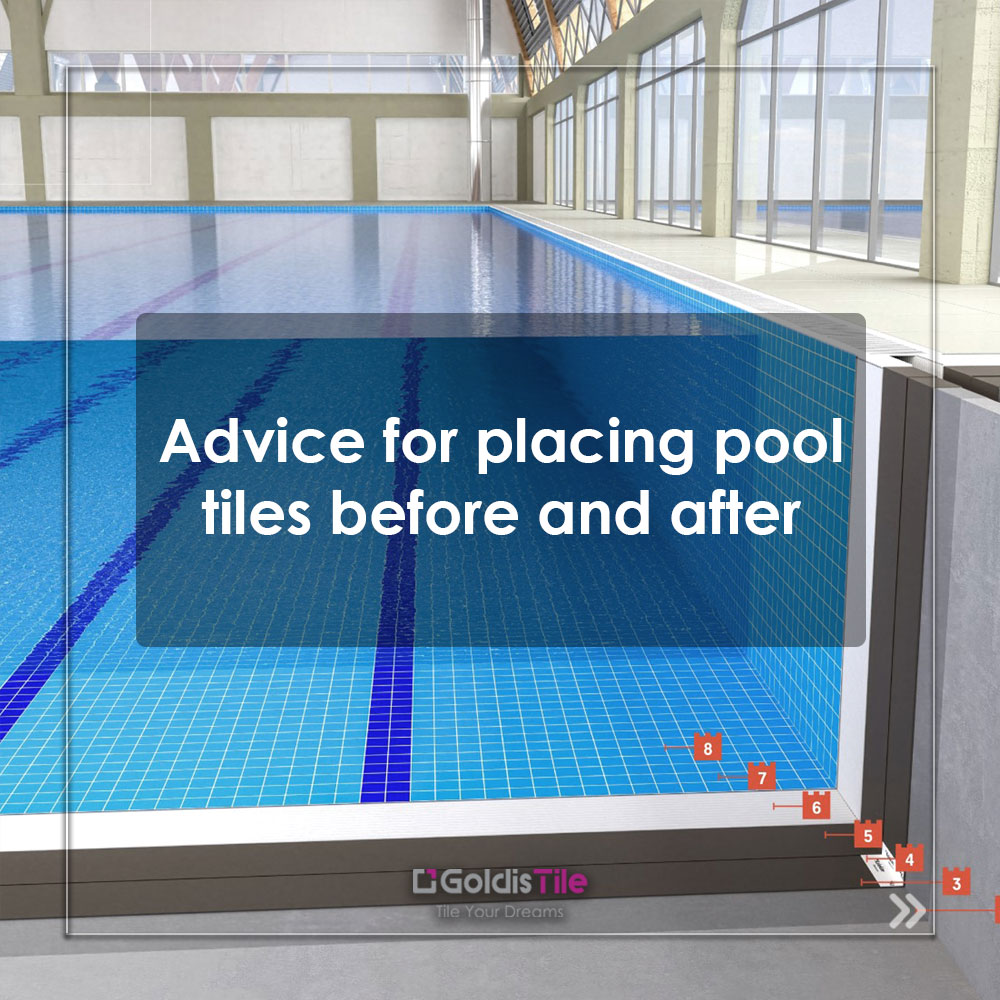The pool is typically created and designed to hold and keep water. No matter why you built this construction, you should be aware that a number of factors need to be taken into account before and after the pool tiles are installed in order to insulate the pool and maintain its aesthetic value. In this situation, you can avoid wasting water and other potential issues in addition to constructing a lovely pool. Keep in mind that by underlaying the pool tile and putting the pool tile with glue, you can stop water from infiltrating the ceramic joint.
If you want to tile the pool’s floor and walls, you should know that using high-quality tiles, ceramics, glues and other materials and following all advice for installing the pool tile cause the tiles durability and its beauty .
The question now is;
How is underlayment for pool tiles made?
How can you avoid water from seeping through the tile and wall seams?
How many materials and how much glue are required to install each ceramic?
Can the swimming pool be used without insulation?
Why are certain pools’ water levels dropping and their garbage accumulation?
What do pool tiles do?
You need first have a basic understanding of what pool tiles are in order to learn the advice before and after installing them. Pool tiles are ceramic or porcelain tile varieties with varying glaze amounts; these tiles are lower in size than building tiles. As a result, it is utilized to decorate and insulate the pool’s floor and body.
Pool tiles are sold in mosaic or a blend of traditional and modern designs. Swimming pools come in a variety of sizes, forms, and colors because, unlike manufactured tiles, they come in a number of shapes and dimensions. You can purchase pool tiles based on the shape and size of the setting you want.
Relevant information on swimming pool tiling
If you plan to glue-install pool tiles after underlaying them, you should be aware of a few important details. Once you’ve identified each one, take urgent action to repair it. Otherwise, the ceramics and infrastructure that are installed on the pool’s body and floor will be harmed. There are three crucial difficulties in this regard, which are as follows:
- Glue and grout
As you are aware, the pool’s body and floor remain submerged in water for a considerable amount of time both day and night. Due to the penetration of water into the ceramics’ seams within a short time, it is regarded as one of the most sensitive wet spots.
Over time, the ceramics get fragmented and the pool loses its aesthetic appeal. Sand and cement mortar, which is used as adhesive and grout, should be used together to avoid this issue.
To insulate the pool’s body and floor is one of the most crucial steps before and after laying pool tiles. Only the use of sturdy ceramic glue and high-quality materials makes this feasible. Therefore, while purchasing them, pay attention to the quantity, quality, and other required accessories.
- Peer pressure
When the pool is empty, the side of the wall exerts a lot of pressure on the tiles and ceramics. When the pool is filled, the side of the water exerts a lot of pressure. As a result, exercise extreme caution when installing the pool’s tiles and insulating it. the seam
them to disentangle themselves from the pool’s body and floor.
chemical compounds
Chlorine and other detergents are used in all swimming pools, especially in swimming training facilities, to disinfect the water. These materials eventually cause water to seep through the pool wall because they degrade the grout’s quality and durability over time. In this regard, you should occasionally insulate the seams of ceramics with ceramic adhesive in addition to using glue to install pool tiles.
pool insulation and sealing
The act of sealing and insulating all of its components is another crucial steps before and after installing pool tiles. At this point, while putting the pool tile with glue, consider the floor’s slope, the pipes’ entrance, and any potential fissures.
The pool’s architecture raises the possibility of leaks and heavy water infiltration. Finally, companies would be successful which offer consumers pools with high quality in terms of their design and aesthetic appeal.
Conclusion
The process of insulating and underlaying the pool floor is crucial because, in addition to preserving the aesthetic appeal of the pool area, it extends the lifespan of the tiles, ceramics, floor, and its body. This can be said based on the information provided above and tips before and after installing pool tiles. We advise using premium ceramic glue with a high adhesive strength if you intend to glue down pool tiles. In this instance, a significant amount of water penetration into the ceramic seam is avoided.



